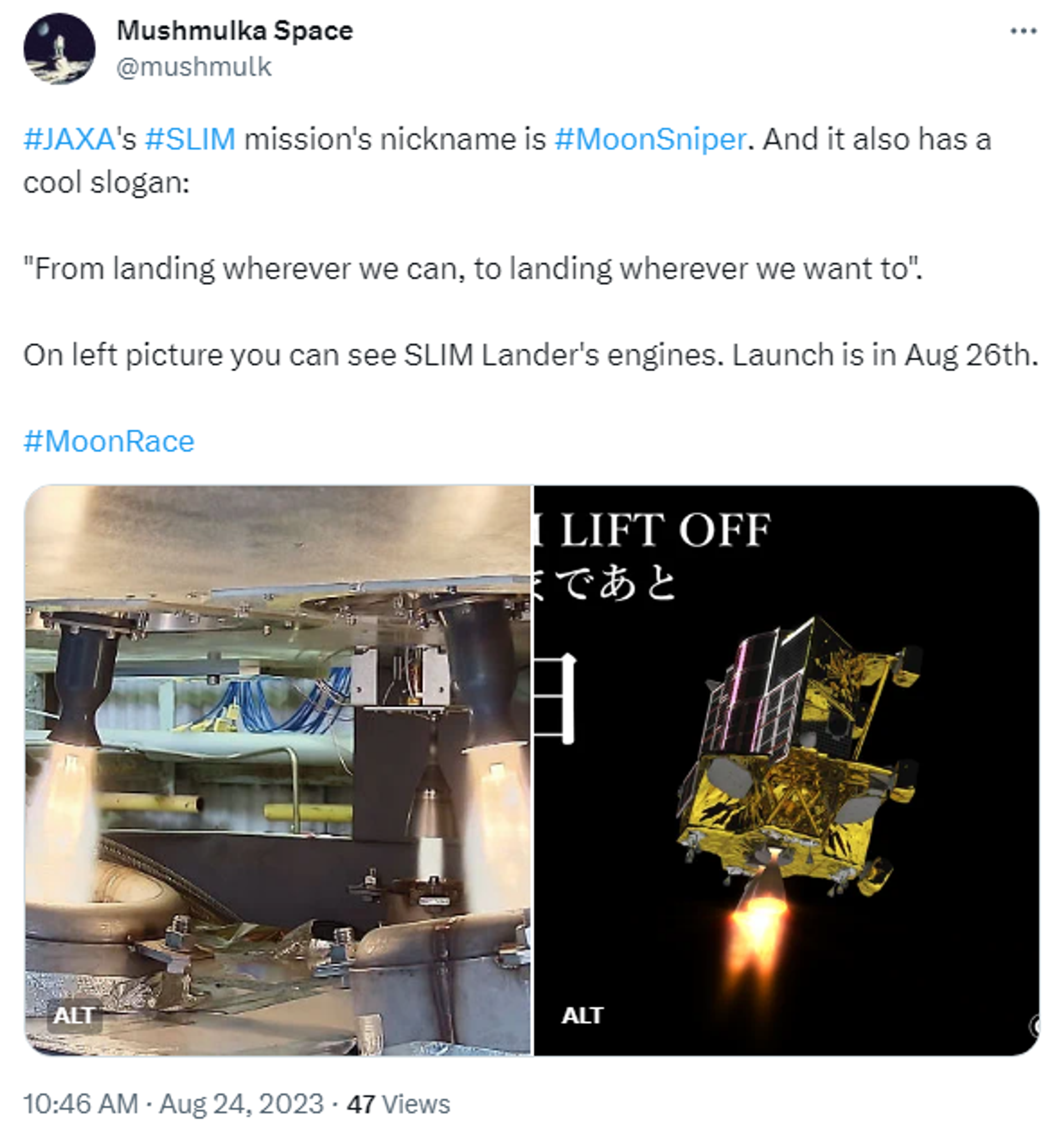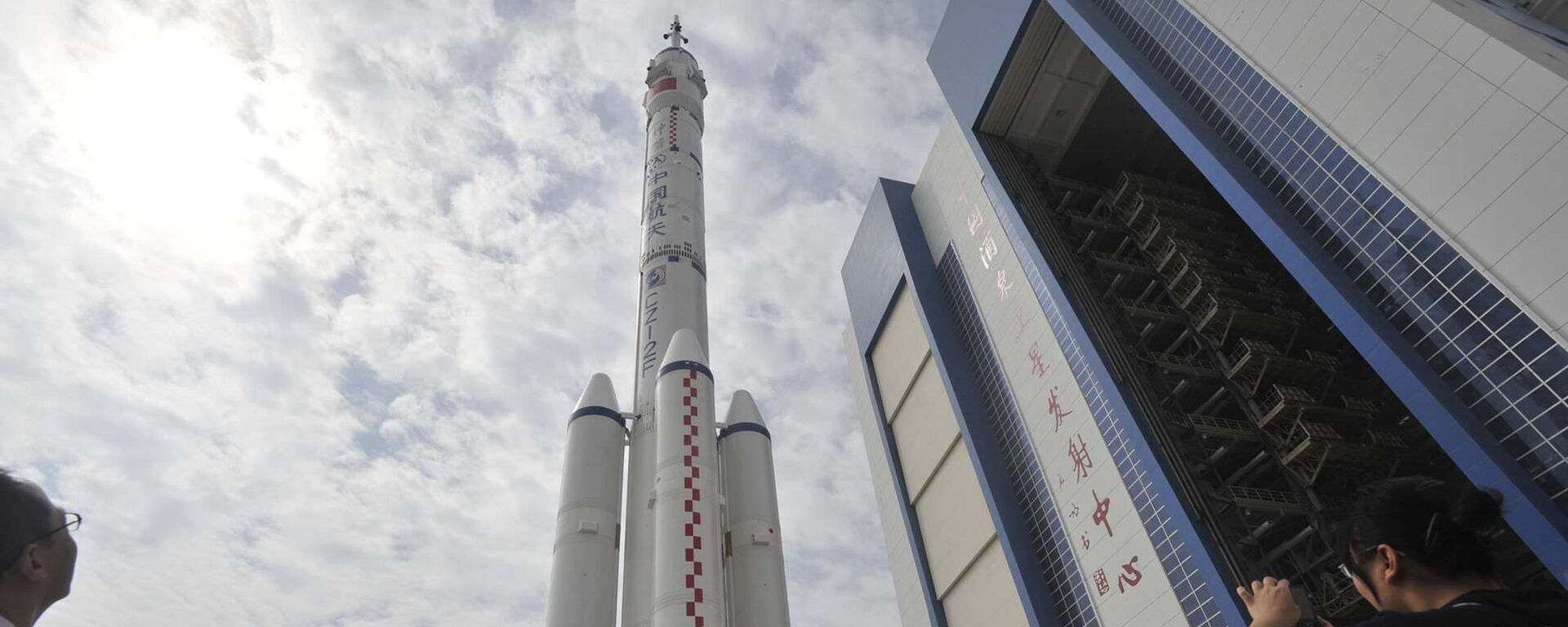https://sputnikglobe.com/20230825/japan-moonstruck-by-recent-slew-of-missions-seeks-lunar-launch-despite-tokyos-setbacks-1112874533.html
Japan, 'Moonstruck' by Recent Slew of Missions, Seeks Lunar Launch Despite Tokyo's Setbacks
Japan, 'Moonstruck' by Recent Slew of Missions, Seeks Lunar Launch Despite Tokyo's Setbacks
Sputnik International
Japan is gearing up to give its moon mission another shot, with Japan Aerospace Exploration Agency (JAXA) banking on the success of its H2-A rocket carrying SLIM, Smart Lander for Investigating Moon.
2023-08-25T08:22+0000
2023-08-25T08:22+0000
2023-08-25T08:22+0000
japan
moon
luna-25 (moon-25)
japan's aerospace exploration agency (jaxa)
jaxa
nasa
chandrayaan-3
tanegashima space center
science & tech
beyond politics
https://cdn1.img.sputnikglobe.com/img/07e7/08/19/1112873825_0:160:3072:1888_1920x0_80_0_0_e50fba9407bb8398fa2f82570d7067c4.jpg
Japan is gearing up to give its moon mission another shot after two uncrewed lunar landers, from Russia and India, were sent into space this August. After the Indian Space Research Organization (ISRO) shared images on Wednesday documenting the Chandrayaan-3’s Vikram lander touching down successfully on the lunar surface, the Japan Aerospace Exploration Agency (JAXA) is now hoping to put its own bout of failures behind it.JAXA is banking on the success of its H2-A rocket, scheduled to take off on August 26 from the Tanegashima Space Center in southern Japan. The Mitsubishi H-IIA (H-2A) active expendable launch system will be carrying Japan’s SLIM (Smart Lander for Investigating Moon). The lightweight lander - dubbed Sniper - is expected to make a soft touchdown on the lunar surface sometime in January or February next year. The purpose of SLIM is to demonstrate “pinpoint landing technology necessary for future lunar probes and verifying this on the surface of the moon with a small scale probe,” as per JAXA.The SLIM lander is described as being 2.4 meters high, 2.7 m wide, 1.7 m deep, and fitted with a landing radar. The lander will be relying on image-matching navigation and obstacle detection equipment, hoping to target a soft touchdown within the Shioli Crater, according to reports. Incidentally, the name of the lander, Sniper, is said to be a nod at how the spacecraft is designed to use its onboard cameras to pinpoint craters, measure positioning, and target a landing area. SLIM, if successful, will "make a qualitative shift towards being able to land where we want and not just where it is easy to land," as per JAXA.Furthermore, the H-2A booster will also be carrying another, different payload – XRISM (X-Ray Imaging and Spectroscopy Mission). The latter is JAXA’s joint initiative with America’s National Aeronautics and Space Administration (NASA), and with ESA participation. XRISM, fitted with a soft X-ray spectrometer, Resolve, and a soft X-ray imager, Xtend, is to “investigate celestial X-ray objects in the Universe with high-throughput imaging and high-resolution spectroscopy,” according to NASA.Costly JAXA Setbacks Japan's new moon mission will come as JAXA has been plagued by launch blunders that have hindered the introduction of a next-generation rocket and thwarted the nation's attempt to launch commercial satellites.The recent list of setbacks includes:Furthermore, Japanese space startups suffered setbacks as well.The Hakuto-R module of the Japanese company ispace, touted as supposed to make the first commercial landing on the Moon after being launched in December 2022 using a Falcon 9 launch vehicle from US company SpaceX, most likely made a hard landing, as a result of which the connection with the device was lost in late March 2023. Ispace vowed to launch its second mission in early 2024.The flurry of lunar activity comes against the backdrop of humanity’s onward space-faring ambitions. Countries like Russia, China, India and the United States are all eying the Moon and its resources. The Moon could become a source of frozen H2O that could be a potential source of drinking water or to make rocket fuel, in turn, to be used for future lunar bases and interplanetary spacecraft missions.
https://sputnikglobe.com/20230824/india-shares-new-images-of-moons-south-pole-after-historic-chandrayaan-3-landing-1112832884.html
https://sputnikglobe.com/20230426/japans-hakuto-r-module-likely-miscalculated-sped-up-moments-before-lunar-crash-1109864387.html
https://sputnikglobe.com/20230725/china-successfully-tests-high-thrust-engine-for-moon-landing-1112137721.html
japan
Sputnik International
feedback@sputniknews.com
+74956456601
MIA „Rossiya Segodnya“
2023
News
en_EN
Sputnik International
feedback@sputniknews.com
+74956456601
MIA „Rossiya Segodnya“
Sputnik International
feedback@sputniknews.com
+74956456601
MIA „Rossiya Segodnya“
japan moon mission, jaxa, japan aerospace exploration agency, slim, smart lander for investigating moon, india's moon mission, chandrayaan-3 mission, chandrayaan-3
japan moon mission, jaxa, japan aerospace exploration agency, slim, smart lander for investigating moon, india's moon mission, chandrayaan-3 mission, chandrayaan-3
Japan, 'Moonstruck' by Recent Slew of Missions, Seeks Lunar Launch Despite Tokyo's Setbacks
The space ambitions of a plethora of countries are linked with the Moon, where only the-then Soviet Union, the US, and China have previously carried out soft landings successfully. A flurry of recent lunar activity, however, has seen India launch its Chandrayaan-3 mission, becoming the fourth country to touch down on the coveted rocky surface.
Japan is gearing up to give its moon mission another shot after two uncrewed lunar landers, from Russia and India, were sent into space this August. After the Indian Space Research Organization (ISRO) shared images on Wednesday documenting the Chandrayaan-3’s Vikram lander
touching down successfully on the lunar surface, the Japan Aerospace Exploration Agency (JAXA) is now hoping to put its own bout of failures behind it.
JAXA is banking on the success of its H2-A rocket, scheduled to take off on August 26 from the Tanegashima Space Center in southern Japan. The Mitsubishi H-IIA (H-2A) active expendable launch system will be carrying Japan’s SLIM (Smart Lander for Investigating Moon). The lightweight lander - dubbed Sniper - is expected to make a soft touchdown on the lunar surface sometime in January or February next year. The purpose of SLIM is to demonstrate “pinpoint landing technology necessary for future lunar probes and verifying this on the surface of the moon with a small scale probe,” as per JAXA.
The SLIM lander is described as being 2.4 meters high, 2.7 m wide, 1.7 m deep, and fitted with a landing radar. The lander will be relying on image-matching navigation and obstacle detection equipment, hoping to target a soft touchdown within the Shioli Crater, according to reports. Incidentally, the name of the lander, Sniper, is said to be a nod at how the spacecraft is designed to use its onboard cameras to pinpoint craters, measure positioning, and target a landing area. SLIM, if successful, will "make a qualitative shift towards being able to land where we want and not just where it is easy to land," as per JAXA.
Furthermore, the H-2A booster will also be carrying another, different payload – XRISM (X-Ray Imaging and Spectroscopy Mission). The latter is JAXA’s joint initiative with America’s National Aeronautics and Space Administration (NASA), and with ESA participation. XRISM, fitted with a soft X-ray spectrometer, Resolve, and a soft X-ray imager, Xtend, is to “investigate celestial X-ray objects in the Universe with high-throughput imaging and high-resolution spectroscopy,” according to NASA.

24 August 2023, 00:10 GMT
Japan's new moon mission will come as JAXA has been
plagued by launch blunders that have hindered the introduction of a next-generation rocket and thwarted the nation's attempt to launch commercial satellites.
The recent list of setbacks includes:
A post-liftoff failure of the solid-fuel Epsilon-6 rocket carrying eight satellites, two of them for the first time commercial ones, in mid-flight, on October 12, 2022. The rocket suffered a malfunction after its launch and was ordered to self-destruct, as per the Japan Aerospace Exploration Agency. A subsequent inquiry determined a faulty part had hindered the rocket from remaining upright to reach orbit.
JAXA was forced to postpone the inaugural launch of the H3, JAXA’s successor to the H-2A, in February 2023, after a system malfunction.
The launch of the
H3 failed in early March was botched after the rocket’s second-stage engine failed to ignite. Operators were forced to send a self-destruct code.
The second stage engine of the Epsilon S rocket
exploded in a test at the Noshiro testing center in Akita Prefecture in July, with JAXA again suffering a setback in an attempt to develop a reliable reusable launcher.
Furthermore, Japanese space startups suffered setbacks as well.
The Hakuto-R module of the Japanese company ispace, touted as supposed to make the first commercial landing on the Moon after being launched in December 2022 using a Falcon 9 launch vehicle from US company SpaceX, most likely made a hard landing, as a result of which the connection with the device was lost in late March 2023. Ispace vowed to launch its second mission in early 2024.
The flurry of lunar activity comes against the backdrop of humanity’s onward space-faring ambitions. Countries like Russia, China, India and the United States are all
eying the Moon and its resources. The Moon could become a source of frozen H2O that could be a potential source of drinking water or to make rocket fuel, in turn, to be used for future lunar bases and interplanetary spacecraft missions.






